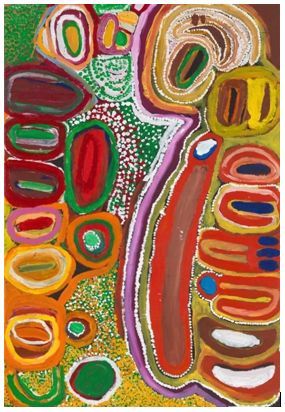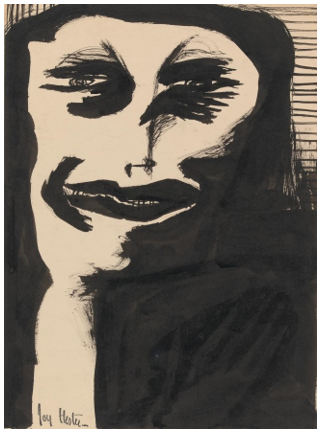Once students can identify art elements, they then need to begin to describe and interpret how the art elements function to create meaning. When writing interpretations of artworks and art elements, students need to
- identify art elements in the artwork(s)
- use the acquired language to describe the art elements
- offer an interpretation of the intended purpose of the described art element.
Teachers can present students with sentence frames or model sentences that demonstrate how to write interpretations of artworks. The strategy below uses a sentence frame to support students to write an interpretation of a given art element.
- The teacher introduces a range of artworks (depending on resources available and student cohort's existing skills and knowledge) either:
- displayed around the room
- via reproductions on slides
- on handout materials that students pass around the room
- via students accessing the internet or an available textbook.
For example, the teacher might use images of artworks from the National Gallery of Victoria Collection, such as Jakayu Biljabu's Minyi Puru (Seven Sisters) (2017).

Jakayu Biljabu
Minyi Puru (Seven Sisters) (2017)
synthetic polymer paint on canvas
179.5 x 122.0 cm
Retrieved from https://www.ngv.vic.gov.au/explore/collection/work/85408/
© Jakayu Biljabu / Copyright Agency, 2020
- Pairs of students are given an art element that is used in the artwork(s).
- After viewing the artwork(s), students write down adjectives or adjective groups, noun groups which include pre-modifiers and/or postmodifiers that describe their art element and how it appears.
- For example, if looking at colour, the students might note that the colours are:
- intense (adjective)
- bright (adjective)
- primary colours (red and yellow) which illuminate the scene (noun group with pre- and postmodifiers)
- The students use these adjectives to write descriptions of the art element.
- For example, the students looking at colour might write, "The primary colours are intense" or "intense, bright primary colours"
- The teacher asks pairs of students to offer their descriptions of the art element and write some of these up on the board.
- The teacher leads a discussion to support students to offer an interpretation of the intended purpose or effect of the described art elements, writing some of the student responses on the board
- For example, the teacher might ask:
- What do bright colours remind you of?
- How do bright colours make you feel?
- What do you think of when you see reds, yellows, and oranges?
- The teacher presents a model sentence structure to show students how to offer an interpretation of an art element in a work. For example:
In <artwork>, <the artist> has used <description of art element> which <intended effect or purpose of art element>.
- Students use the model sentence structure to write their own interpretations of the art element they have described.
- For example, the students focussing on colour might write, "In Minyi Puru (Seven Sisters), Biljabu has used intense primary and secondary colours which give an impression of strength and permanence.
Below is another sentence a student has written analysing the use of colour and line in Joy Hester's Untitled (Woman in Black) (c. 1948).
In Joy Hester's untitled work also known as Woman in Black, the use of monochromatic colour and bold line create drama and a sense of unease.

Joy Hester
Untitled (Woman in Black) (circa 1948)
brush and ink
37.2 x 26.9 cm irregular
Retrieved from https://www.ngv.vic.gov.au/explore/collection/work/25244/
Curriculum links for the above examples: VCAVAE034, VCAVAR038, VCAVAR039, VCAVAE041, VCAVAR045, VCAVAR046.